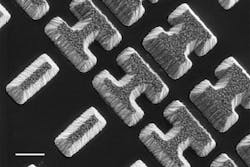Chalcogenide nanofeatures on calcium fluoride bring metalens technology to the mid-IR
Metamaterial optics, usually in the form of a nanostructured metasurface, have the potential to be transformative for precision optics. Existing metasurface optics have been fabricated that operate in the visible and near-IR regions; the mid-IR, due to its different set of optical materials, has been left out.
RELATED: Metamaterials: High-efficiency achromatic metasurface focuses over wide angle
RELATED: These metalenses are actually practical
RELATED: New polarimeter from Capasso's lab at Harvard can be integrated on a chip
Now, scientists at the Massachusetts Institute of Technology (MIT; Cambridge, MA), the University of Electronic Science and Technology of China, and the East China Normal University have rectified this situation by creating diffraction-limited mid-IR metasurface optics using chalcogenide-alloy nanofeatures lithographically fabricated on calcium fluoride (CaF2) substrates.1 Such optics could help to simplify and lighten the weight of mid-IR sensing instruments for the detection of biomolecular and chemical signals.
The wideband properties of chalcogenide and CaF2 enable optical designs to be created anywhere within a wide portion of the mid-IR. The transmissive optical efficiencies of the diffraction-limited fabricated devices ranged up to 75% for linearly polarized light.
"This kind of metasurface can be made using standard microfabrication techniques," says Tian Gu, one of the researchers. "The manufacturing is scalable."
The research was funded by the Defense Advanced Research Projects Agency (DARPA), under the Extreme Optics and Imaging Program, and the National Natural Science Foundation of China.
Source: http://news.mit.edu/2018/improving-mid-infrared-imaging-and-sensing-0426
REFERENCE:
1. Li Zhang et al., Nature Communications (2108); doi: 10.1038/s41467-018-03831-7.
About the Author
John Wallace
Senior Technical Editor (1998-2022)
John Wallace was with Laser Focus World for nearly 25 years, retiring in late June 2022. He obtained a bachelor's degree in mechanical engineering and physics at Rutgers University and a master's in optical engineering at the University of Rochester. Before becoming an editor, John worked as an engineer at RCA, Exxon, Eastman Kodak, and GCA Corporation.

